Kauai, also known as the ‘Garden Island’ of Hawaii, is home to a diverse array of bird species that are endemic to this region. Being one of the most remote islands, the birdlife in Kauai is unique and has evolved to adapt to the island’s natural habitats.
The island’s geographical location, with its mountain ranges, deep valleys, and numerous streams, provides an ideal setting for many bird species to thrive.
In this article, we will explore the intriguing avian world of Kauai and the many bird species that call this island home.
From the colorful and vocal Hawaiian honeycreepers to the elusive and endangered waterbirds, Kauai’s birdlife is a natural wonder to behold.
1. Red Junglefowl
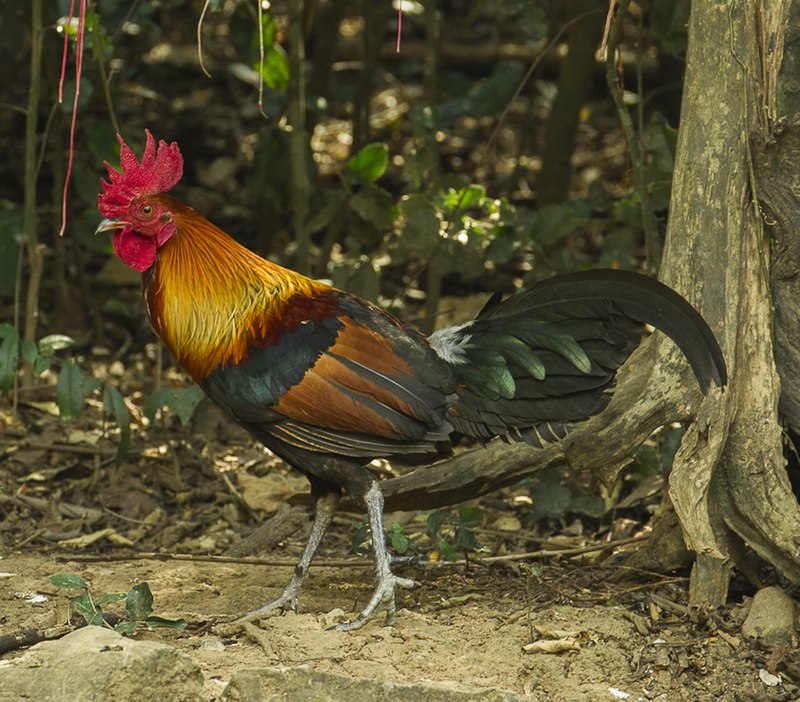
The Red Junglefowl is a tropical bird belonging to the Phasianidae family, native to much of Southeast Asia and parts of South Asia. It has been referred to as Bankiva or Bankiva Fowl in the past.
This species was instrumental in giving rise to chickens (Gallus gallus domesticus) that are commonly domesticated today.
In addition, it has contributed genetic material along with Grey Junglefowl, Sri Lankan Junglefowl and Green Junglefowl towards creation of various breeds found around the world.
The male red jungle fowls have a distinctive long tail while they also boast iridescent patches on their neck feathers which develop during mating season for display purposes.
They mainly feed on plants & insects but may occasionally consume lizards too.
Scientific classification:
| Kingdom | Animalia |
| Phylum | Chordata |
| Class | Aves |
| Order | Galliformes |
| Family | Phasianidae |
| Genus | Gallus |
| Species | G. gallus |
Also Featured In: Common Birds in India, Birds That Live in the Jungle
2. Nene
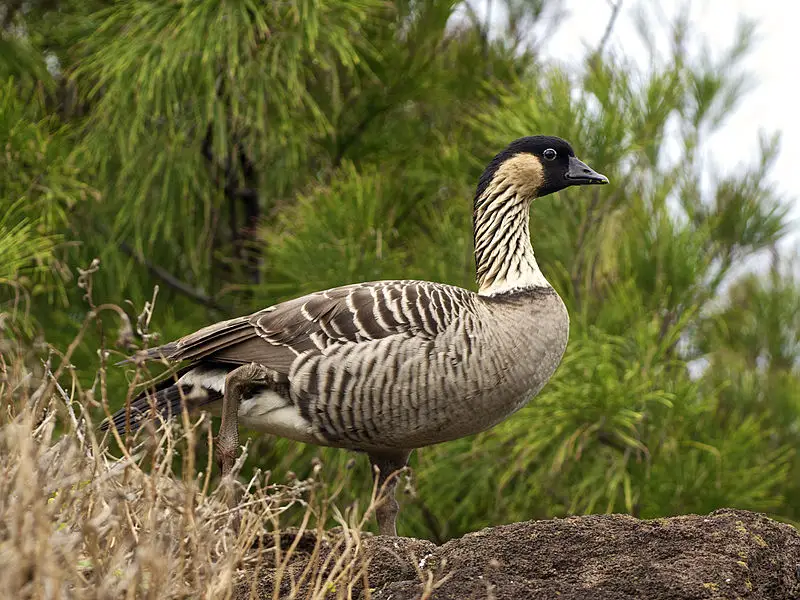
The Nene is a species of bird endemic to the Hawaiian Islands. It was given its name ‘nēnē’ due to its soft call and in 1957 it even became the official state bird of Hawaii.
This gorgeous goose can be found exclusively in the wild on islands such as Oahu, Maui, Kauaʻi, Molokai and Hawaiʻi.
The Nene has adapted so well to living within these different island environments that they have developed their own distinct subspecies depending on which island they are from.
These birds are an important part of Hawaiian culture, being featured in many stories throughout history where they were often seen as symbols for protection and good luck – making them truly special creatures indeed.
Scientific classification:
| Kingdom | Animalia |
| Phylum | Chordata |
| Class | Aves |
| Order | Anseriformes |
| Family | Anatidae |
| Genus | Branta |
| Species | B. sandvicensis |
Also Featured In: Most Common United States Birds, Molokai Birds You Need To Know
3. Common Myna
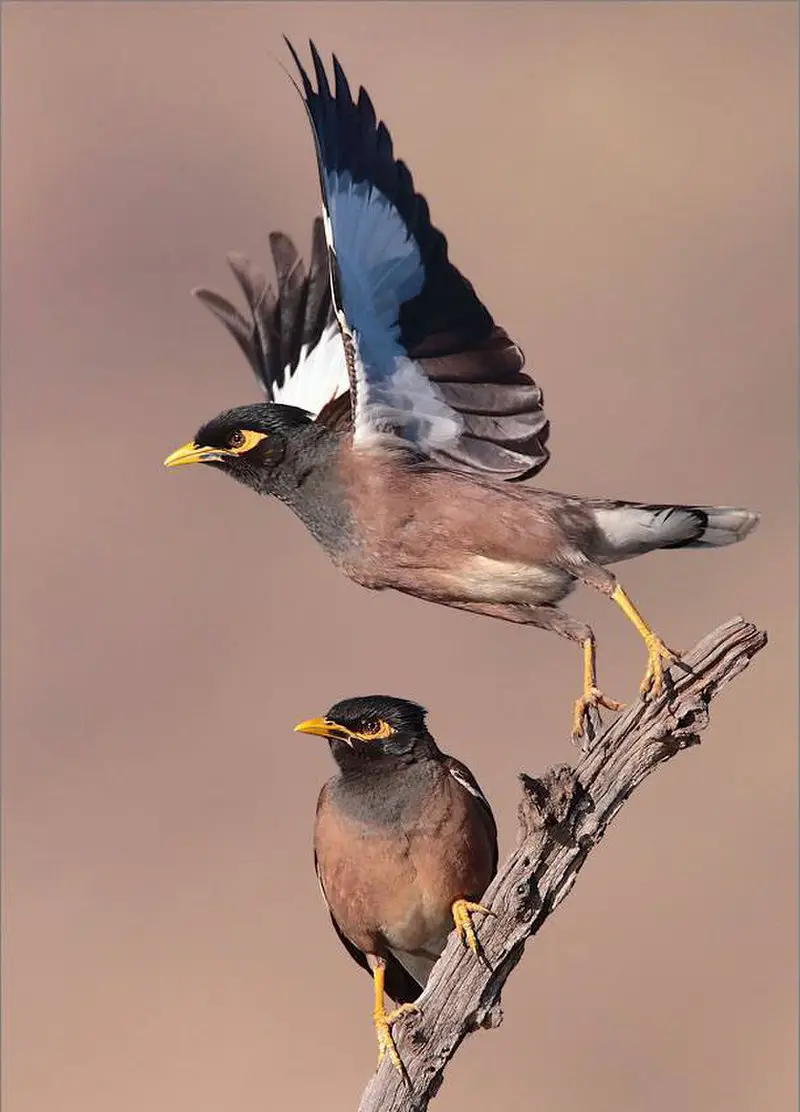
The Common myna is a bird native to Asia and belongs to the Sturnidae family. It has an omnivorous diet, strong territorial instinct and is well adapted to urban environments.
With its range increasing rapidly, it was declared one of the most invasive species by IUCN in 2000. Its distinctive features include black head with a yellow bill, brown body and white tips on wings & tail feathers.
The common myna communicates through loud clicking noises that can easily be heard from long distances in both rural as well as urban areas alike.
They are known for their intelligence; they mimic sounds such as human speech or other birds’ calls making them popular pets among households too.
Scientific classification:
| Kingdom | Animalia |
| Phylum | Chordata |
| Class | Aves |
| Order | Passeriformes |
| Family | Sturnidae |
| Genus | Acridotheres |
| Species | A. tristis |
Also Featured In: Most Common Types of Bangladeshi Birds, Common Birds in the Cities
4. Zebra Dove
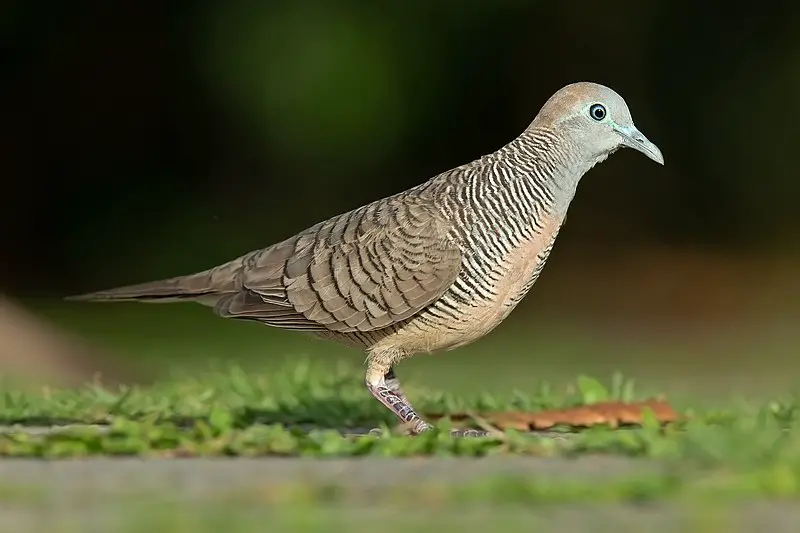
The Zebra Dove is a species of bird belonging to the Columbidae family. It can be found in Southeast Asia, and has predominantly brownish-grey feathers with black-and-white barring.
This dove stands out for its soft, pleasant cooing calls that sound like staccato notes when heard together. George Edwards first described it in 1743 as part of his English naturalist work on birds.
They are small animals with long tails, making them easily identifiable even from afar due to their distinct color patterning.
These doves prefer open woodlands or grassy areas near human settlements where they feed on seeds and insects while nesting close by but still far enough away from disturbance caused by humans or other animals who might disrupt their habitat.
The zebra dove is considered an important symbol among some Asian cultures representing love & beauty , reflecting how this little creature manages to capture people’s hearts wherever it goes.
Scientific classification:
| Kingdom | Animalia |
| Phylum | Chordata |
| Class | Aves |
| Order | Columbiformes |
| Family | Columbidae |
| Genus | Geopelia |
| Species | G. striata |
Also Featured In: Birds of the Philippines, White Oahu Birds
5. Black-Crowned Night Heron
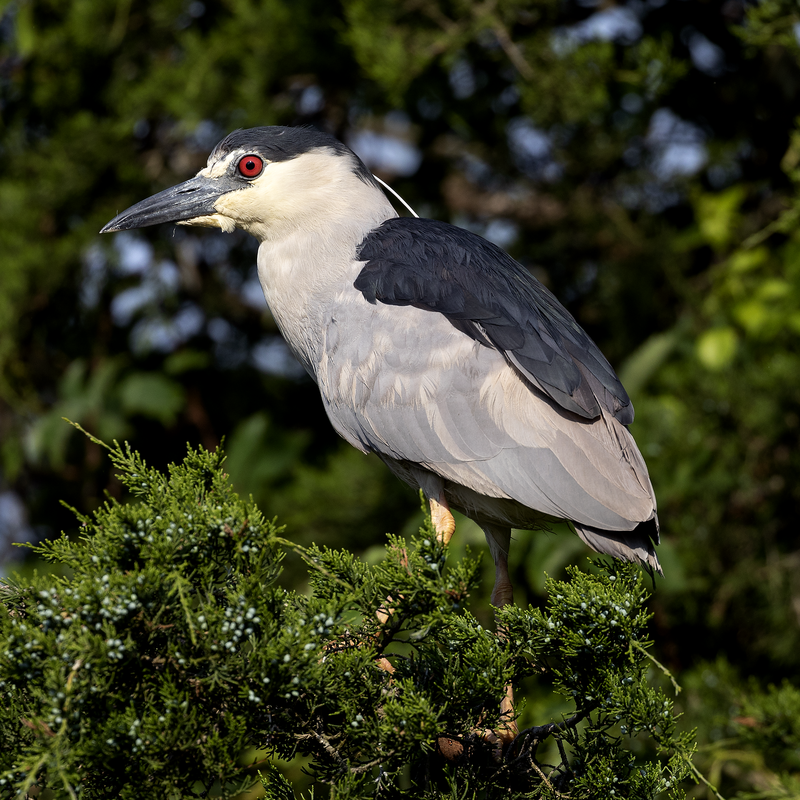
The Black-crowned night heron (Nycticorax nycticorax) is a medium-sized bird found in various parts of the world, including Europe, Asia and North and South America.
It has black crowns on its head with white feathers underneath. Its wings are greyish brown while its underparts are mostly white.
This species can be seen foraging near shallow water or along coastlines during dusk or dawn as it hunts small fish, amphibians and crustaceans.
They also feed on insects such as grasshoppers and beetles which they find in meadows close to freshwater bodies like lakes or ponds where they breed during springtime making nests using twigs lined with reeds and leaves near these waterside habitats.
In Australasia, this species hybridizes with the nankeen night heron that inhabits those areas instead; however both populations remain distinct from each other despite their overlap range regions.
Scientific classification:
| Kingdom | Animalia |
| Phylum | Chordata |
| Class | Aves |
| Order | Pelecaniformes |
| Family | Ardeidae |
| Genus | Nycticorax |
| Species | N. nycticorax |
Also Featured In: Common Birds Found in Switzerland, Flight Birds You Should Know
6. Red-Crested Cardinal
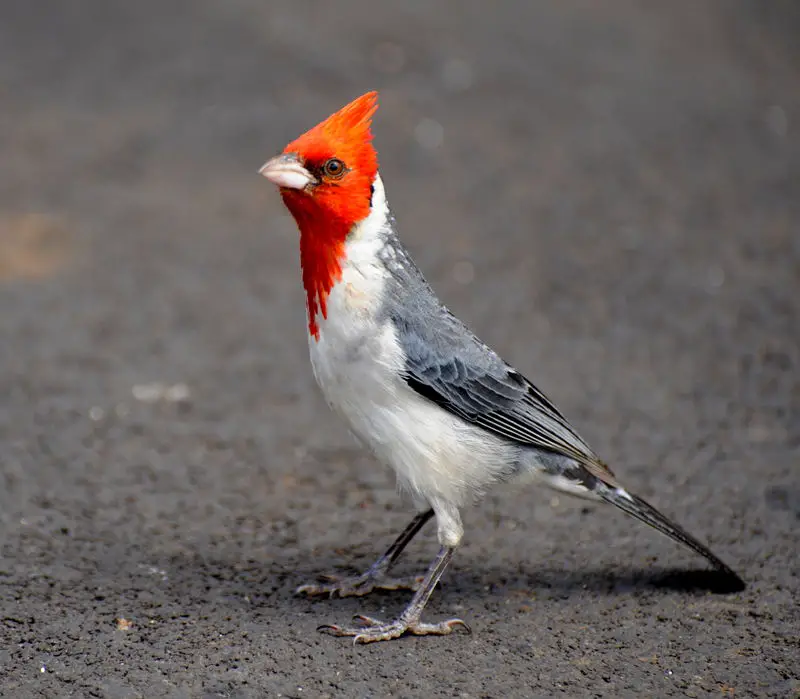
The Red-crested Cardinal is a brightly colored songbird belonging to the family of tanagers. It has a vibrant red crest and its name comes from the Tupí people, which means “small red, yellow, and gray bird”.
This species can be found in most parts of South America where it prefers open woodlands or grassy areas near rivers.
Its diet consists mainly of insects but also includes some fruit when available. The Red-crested Cardinal is well known for its melodious songs that are used by males to attract mates during breeding season.
These birds form monogamous pairs with both parents helping out with raising their young until they learn how to fly on their own within 21 days after hatching from eggs in nest made up high trees or bushes.
In recent years there have been reports about population decline due loss habitat caused by deforestation as well as illegal hunting for pet trade business so conservation efforts are necessary in order to protect this beautiful species from extinction.
Scientific classification:
| Kingdom | Animalia |
| Phylum | Chordata |
| Class | Aves |
| Order | Passeriformes |
| Family | Thraupidae |
| Genus | Paroaria |
| Species | P. coronata |
Also Featured In: Most Common Birds In Paraguay, White Birds Commonly Found in Hawaii
7. White-Tailed Tropicbird
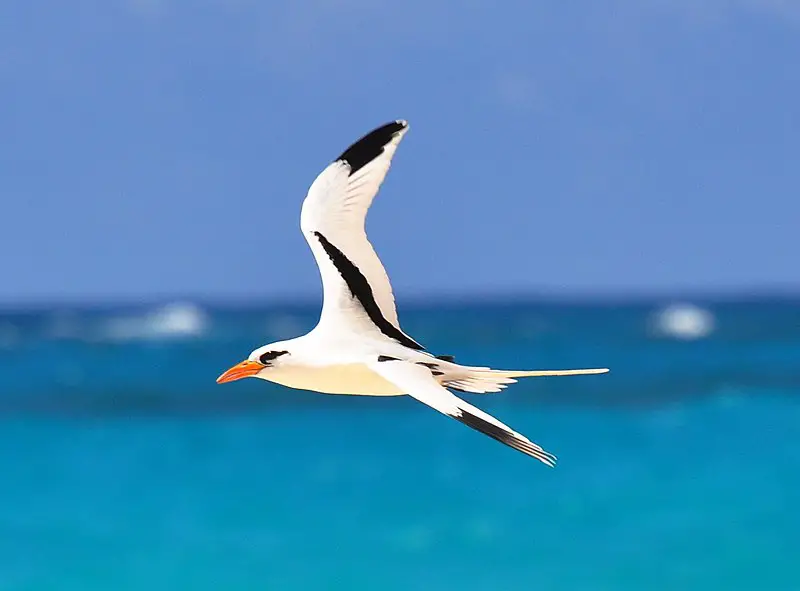
The White-tailed Tropicbird is a beautiful seabird that lives in the tropical waters of the Atlantic, Pacific, and Indian Oceans.
It is the smallest member of its order Phaethontiformes, measuring only 28 inches from head to tail.
Its wingspan can reach up to 45 inches wide. The bird has white plumage with black markings on its wings and tail feathers.
It also has an unmistakable long streamer which trails out behind them when they are in flight – a characteristic feature for all tropicbirds.
They nest mainly on remote islands throughout their range but have recently begun nesting on Little Tobago as well.
These birds feed primarily off flying fish or squid near the ocean’s surface during daylight hours before returning back home at nightfall.
Scientific classification:
| Kingdom | Animalia |
| Phylum | Chordata |
| Class | Aves |
| Order | Phaethontiformes |
| Family | Phaethontidae |
| Genus | Phaethon |
| Species | P. lepturus |
Also Featured In: Mauritius birds, Birds You’ll Find in the Sea
8. Red-Footed Booby
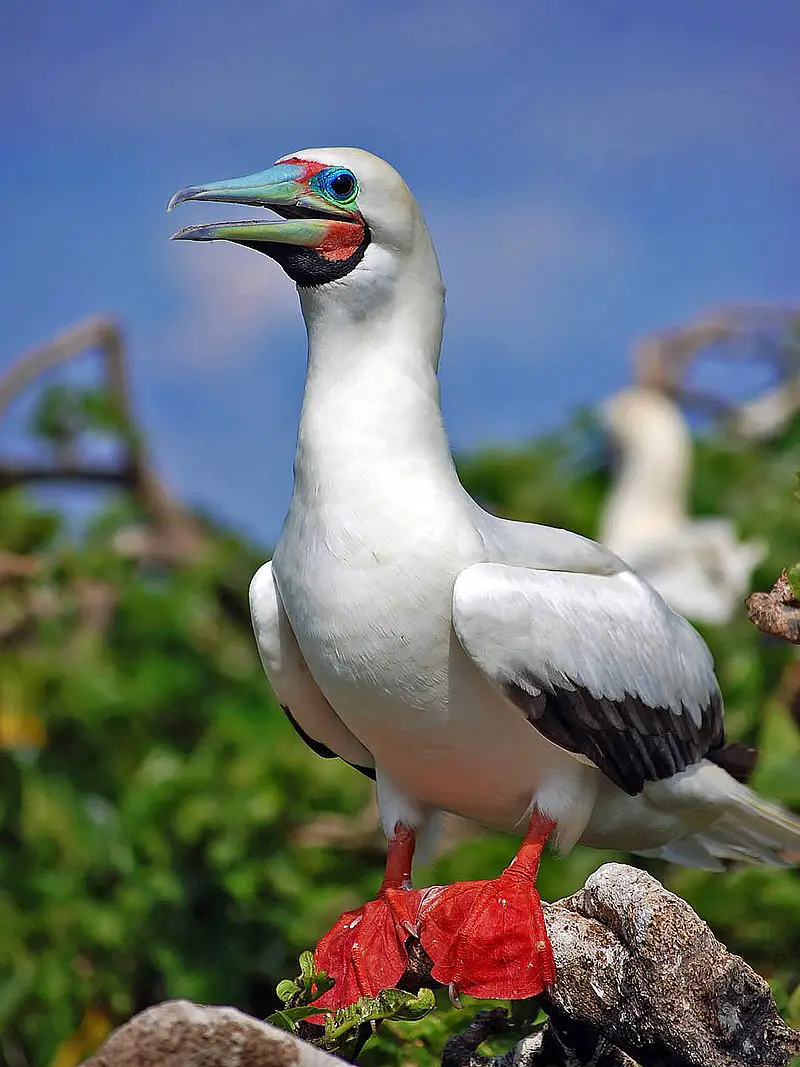
The Red-footed Booby is a large seabird of the Sulidae family, easily distinguished by its bright red feet. These birds are strong and agile fliers but can be clumsy in takeoffs and landings.
They live mostly in tropical areas and breed colonially on coastal islands all over the world.
The species faces few threats from either nature or humans, however their population has decreased slightly due to disturbances near breeding sites.
Despite this mild decline, they remain an incredibly common sight across many parts of the tropics – so much so that they have become symbolic with island life.
Scientific classification:
| Kingdom | Animalia |
| Phylum | Chordata |
| Class | Aves |
| Order | Suliformes |
| Family | Sulidae |
| Genus | Sula |
| Species | S. sula |
Also Featured In: Cabo Verde birds, Birds that Live in the Ocean
9. Great Frigatebird
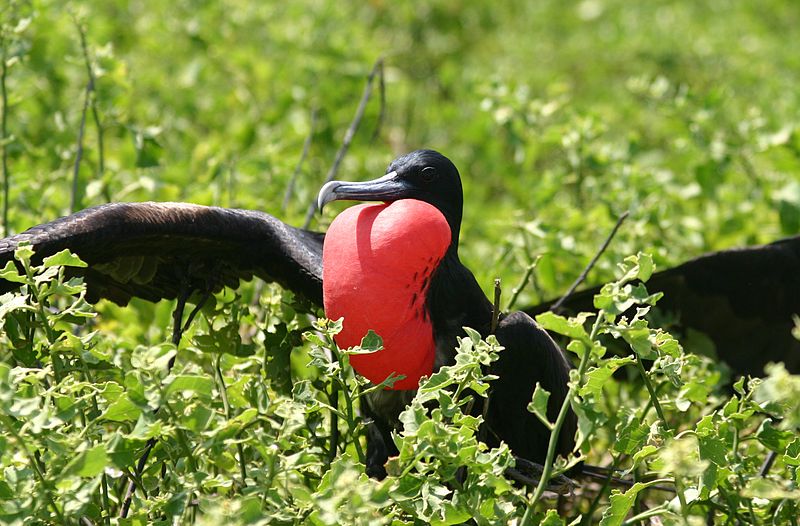
The Great Frigatebird is a large seabird found in tropical regions of the Pacific and Indian Oceans, as well as the South Atlantic.
It can grow up to 105 cm long with black plumage, making it one of the largest frigatebirds around.
The species also exhibits sexual dimorphism; males have bright red throat pouches while females have white or grey ones instead.
These birds nest in colonies on islands or near coastal areas where they feed off fish schools, squid and other marine life that they snatch from their dive-bombing prey.
They are highly adept at soaring for hours above oceanic waters searching for food sources below them before dives down into shallow water to catch unsuspecting meals.
Scientific classification:
| Kingdom | Animalia |
| Phylum | Chordata |
| Class | Aves |
| Order | Suliformes |
| Family | Fregatidae |
| Genus | Fregata |
| Species | F. minor |
Also Featured In: Christmas Island Birds, Galapagos Birds You Should Know
10. Hawaiian Honeycreeper
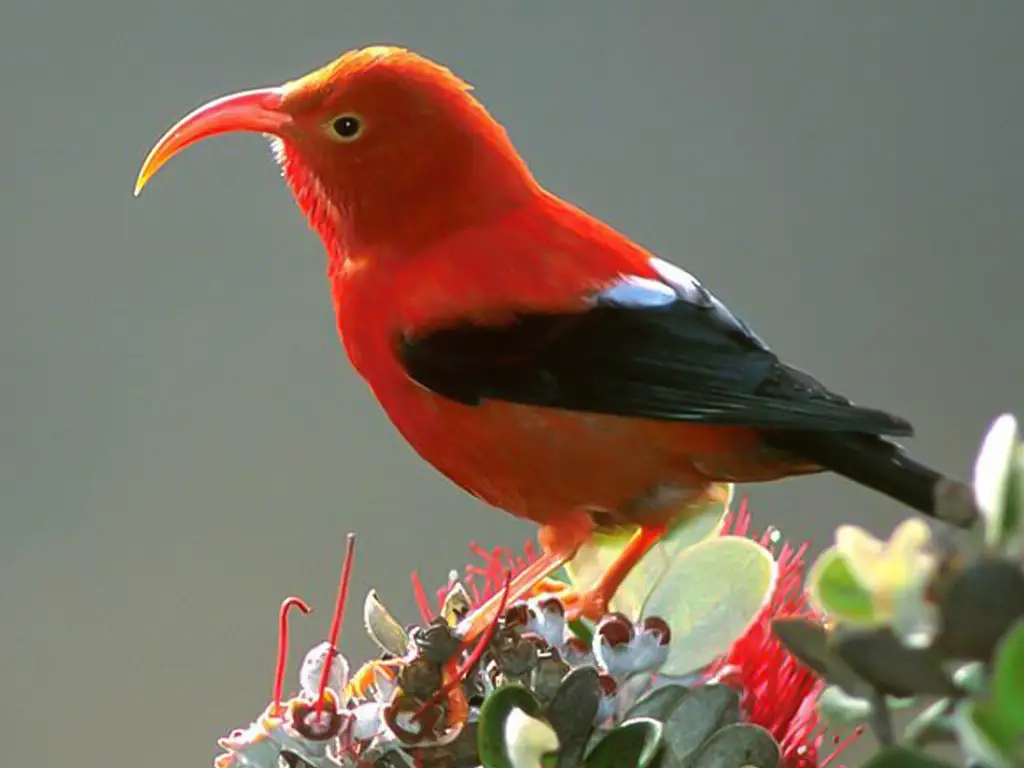
The Hawaiian honeycreepers are a unique group of birds native to the Hawaiian Islands. These small passerines have adapted features not seen in any other finch, making them incredibly diverse.
Sadly, since human arrival in Hawaii many species of these beautiful creatures have been driven to extinction due to habitat destruction and competition with invasive species such as rats and mongooses.
However, conservation efforts are ongoing which aim to protect remaining populations from further decline and reintroduce extinct ones back into their former habitats where possible.
With luck we may one day be able to once again see flocks of brilliantly coloured honeycreepers grace Hawaii’s skies.
Scientific classification:
| Kingdom | Animalia |
| Phylum | Chordata |
| Class | Aves |
| Order | Passeriformes |
| Family | Fringillidae |
| Subfamily | Carduelinae |
Also Featured In: Hawaii Birds, Birds that Found in Maui
11. Hawaiian Petrel
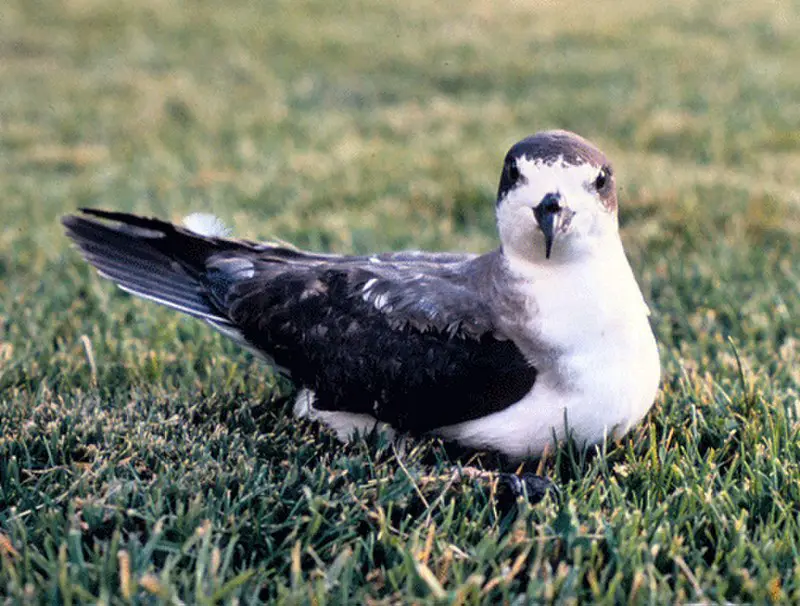
The Hawaiian petrel, or ʻuaʻu, is an endemic species to Hawai’i. Its striking dark gray-brown and white plumage makes it easily identifiable amidst the other birds of the islands.
It was once found on all main Hawaiian Islands except Niʻihau but has since been mostly restricted to Haleakalā crater on Maui with smaller populations inhabiting Mauna Loa on Hawai’i and Waimea Canyon and Lāna‘ihale on Kaua’i.
This seabird feeds mainly at night by diving into water for small fish, squid, octopus and crustaceans.
The female lays a single egg in burrows located up high in protected mountain slopes where they remain until fledging after 3 months of incubation period by both parents.
To ensure their continued survival these pets are protected from human activities through conservation efforts such as predator control programs that help protect newly hatched young from owls predating them before flight readiness.
Scientific classification:
| Kingdom | Animalia |
| Phylum | Chordata |
| Class | Aves |
| Order | Procellariiformes |
| Family | Procellariidae |
| Genus | Pterodroma |
| Species | P. sandwichensis |
Also Featured In: Most Common Oahu Birds, Hawaii Big Island Birds You Should Know
12. Hawaiʻi ʻamakihi
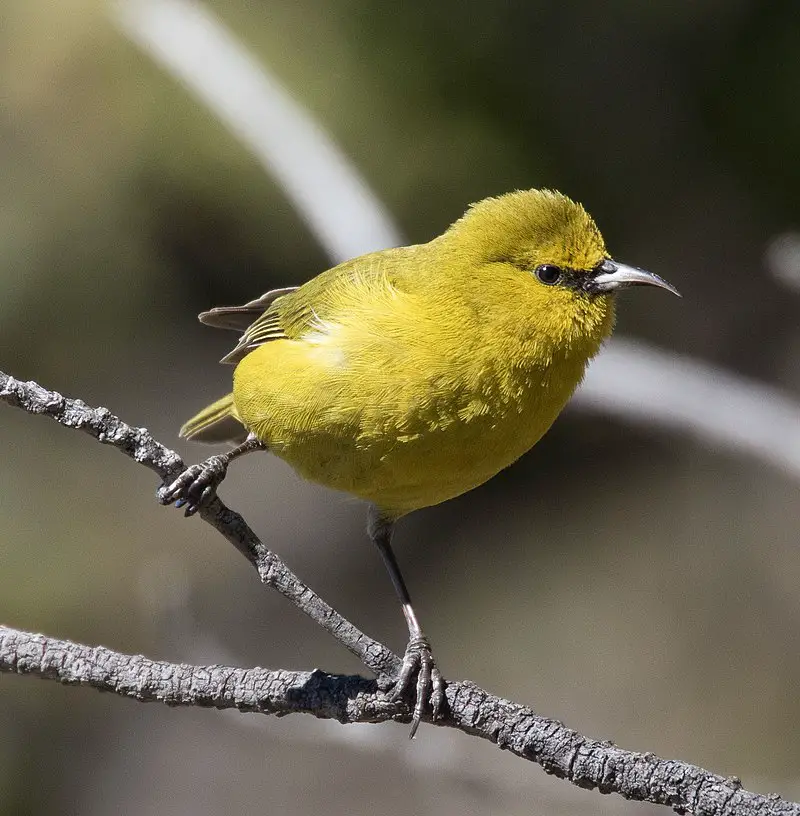
Hawaiʻi ʻamakihi is a species of Hawaiian honeycreeper belonging to the genus Chlorodrepanis.
It was previously placed in the Hemignathus group, but was reclassified based on mitochondrial and nuclear DNA sequences analysis.
The two recognized subspecies are C. v. wilsoni found on Maui, Molokaʻi, and Lanai; and C. vvirens occurring throughout Hawai’I Island except for Kona district where it has been extirpated due to habitat destruction from human activities such as urbanization and agriculture development.
The Hawaii amakihinest is mainly in lowland ōhi’a forest dominated by Metrosideros polymorpha trees at elevations up 900-1,800 meters (3,000–6,000 ft).
With its bright yellow breast feathers adorning its olive green body plumage, the Hawai` i `Amakihiflies gracefully through forests searching for nectar sources like flowers or insects.
Scientific classification:
| Kingdom | Animalia |
| Phylum | Chordata |
| Class | Aves |
| Order | Passeriformes |
| Family | Fringillidae |
| Subfamily | Carduelinae |
| Genus | Chlorodrepanis |
| Species | C. virens |
13. ʻApapane
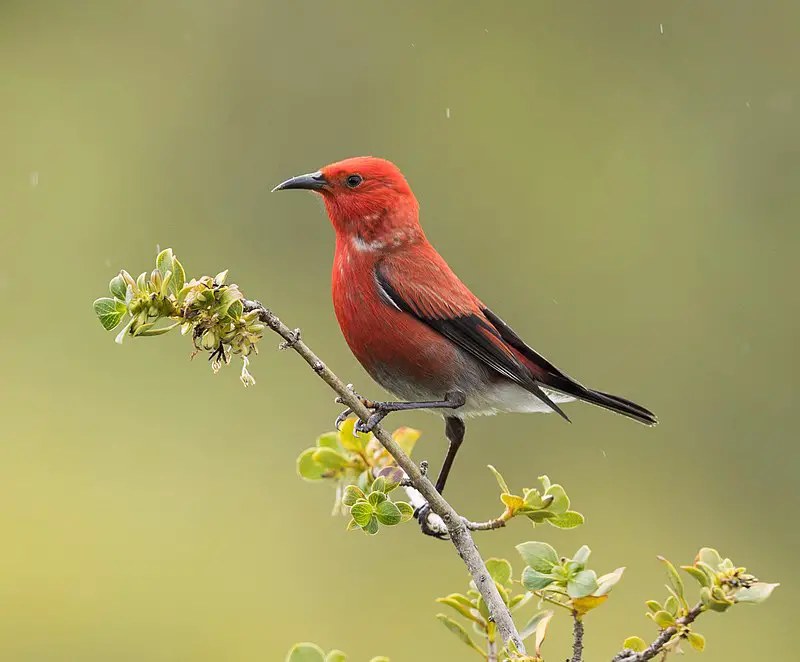
The ‘Apapane is a beautiful bird native to the Hawaiian Islands. It has bright crimson feathers and is a member of the honeycreeper family.
This small species can be found on all main islands, including Hawaiʻi, Maui, Lānaʻi, Kauaʻi, Molokaʻi and Oahu.
These birds are most commonly seen in ōhi’a trees where they feed off nectar from flowers as well as insects that live among the foliage.
They nest high up in these tall hardwood trees and also soar through rainforest treetops looking for food sources with their long wingspan.
The ‘Apapane’s vibrant coloration makes it an iconic symbol of Hawaii’s diverse wildlife landscape; its cheerful presence often bringing joy to visitors who have come to explore this tropical paradise.
Scientific classification:
| Kingdom | Animalia |
| Phylum | Chordata |
| Class | Aves |
| Order | Passeriformes |
| Family | Fringillidae |
| Subfamily | Carduelinae |
| Genus | Himatione |
| Species | H. sanguinea |
Also Featured In: Red Birds that Found in the United States America, Native Birds Of Kure Atoll
14. Hawaiʻi ʻelepaio
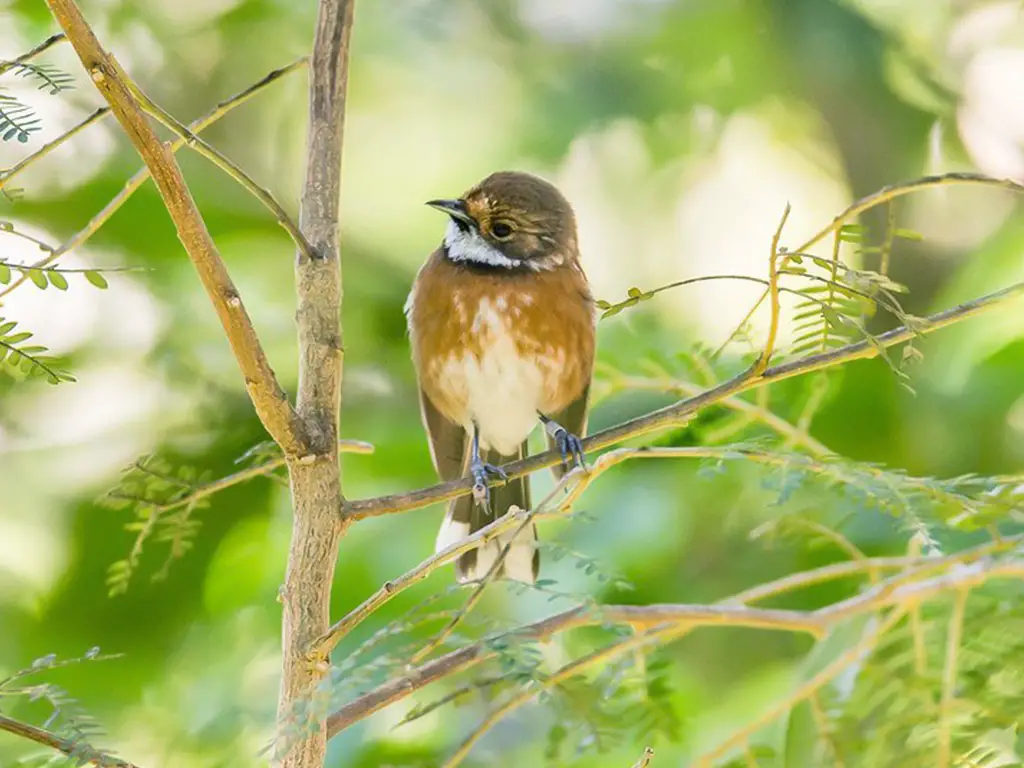
The Hawaiʻi ʻelepaio is a small bird native to the Big Island of Hawaii. It belongs to the monarch flycatcher family and until 2010, it was classified as one species alongside two other subspecies; Kauaʻi ʻelepaio and Oahu ʻelepaio.
This vibrant colored bird boasts black upperparts with white wingbars, a gray head and an orange-yellow breast.
It also has unique vocalizations which sound like “chee-dee” or “chup” while they are singing or searching for food in trees during their active daytimes.
The Hawai’i ‘Elepaios feed on insects such as beetles, spiders, caterpillars by gleaning them from foliage near ground level up into canopy layers of trees – making them difficult to spot.
Considering these birds have been around since before 1800s when first discovered by Europeans settlers – there’s no doubt that this beautiful creature will remain part of Hawaiian culture for years to come.
Scientific classification:
| Kingdom | Animalia |
| Phylum | Chordata |
| Class | Aves |
| Order | Passeriformes |
| Family | Monarchidae |
| Genus | Chasiempis |
| Species | C. sandwichensis |
15. Pacific Golden Plover
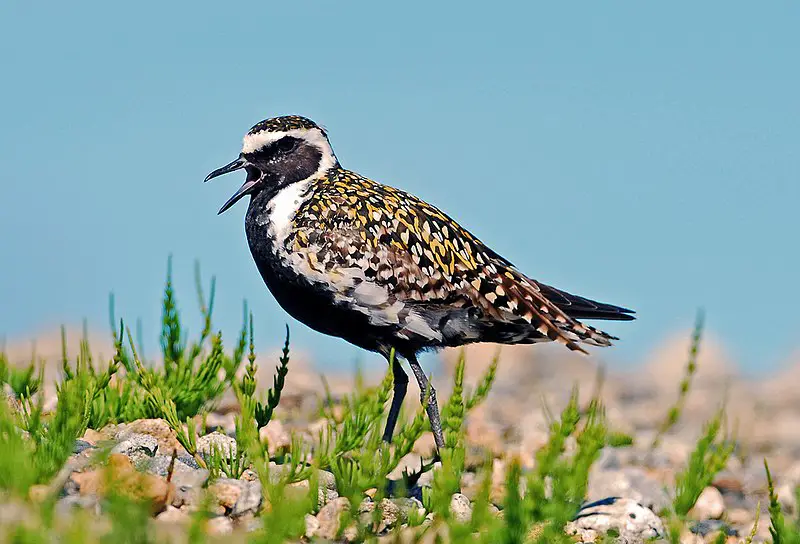
The Pacific golden plover (Pluvialis fulva) is an attractive migratory shorebird known for its breeding habits in Alaska and Siberia.
During the nonbreeding season, these medium-sized birds migrate widely across the Pacific.
It was formally described by Johann Friedrich Gmelin in 1789 as part of his revised edition of Carl Linnaeus’s Systema Naturae.
The species has a unique yellowish colouration with dark markings on their wings and back which gives them splendid camouflage against coastal rocks or sand beaches during migration periods.
They are omnivorous feeders who primarily eat insects, small crustaceans, worms and plant material like seeds or berries found along coastlines while migrating through various islands such as Hawaii, New Zealand etc.. A remarkable bird that possesses both beauty and resilience.
Scientific classification:
| Kingdom | Animalia |
| Phylum | Chordata |
| Class | Aves |
| Order | Charadriiformes |
| Family | Charadriidae |
| Genus | Pluvialis |
| Species | P. fulva |
Also Featured In: Birds You’ll Find in Vancouver Island, Birds that Migrate to Sri Lankan
16. Newell’s Shearwater
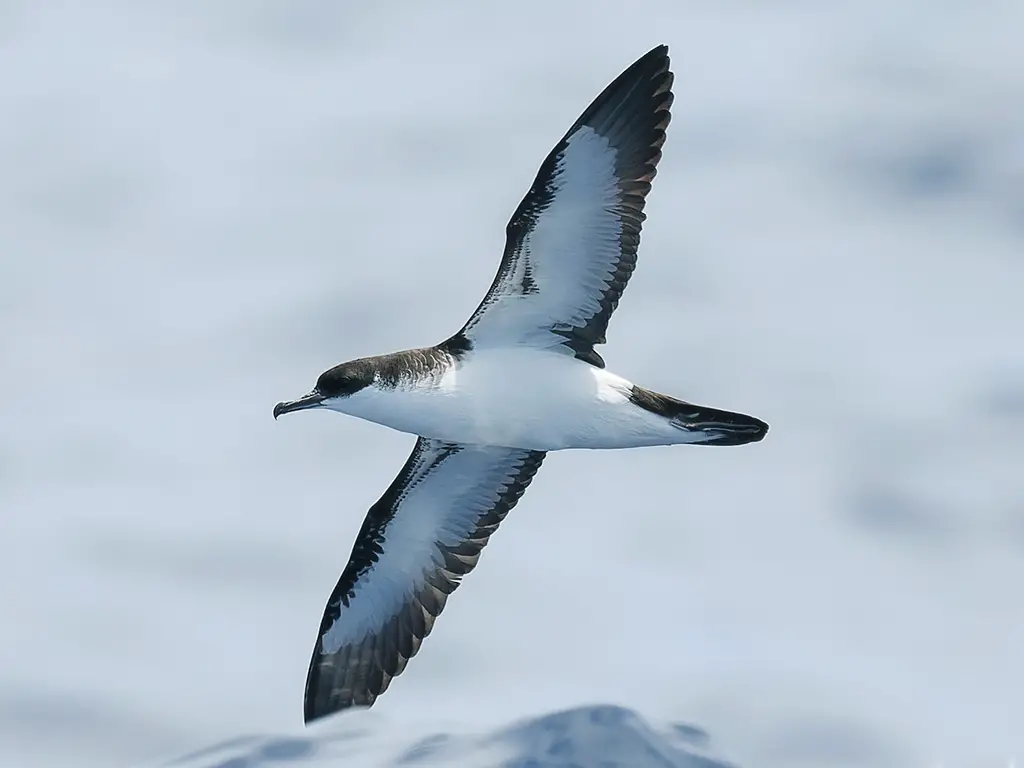
Newell’s Shearwater, also known as the Hawaiian Shearwater, is an ocean bird belonging to the family Procellariidae.
This species can be difficult to identify due to its similarities with other shearwaters and its somewhat controversial classification – it was formerly treated as a subspecies of Manx shearwater but now more commonly placed in Townsend’s shearwater.
It is endemic to Hawaii where they breed on several offshore islands such as Maui’s Molokini Islet and Lana’i Island.
These birds are mostly dark brown with white bellies and have short wings which enable them to soar over long distances at sea while searching for food like flying fish eggs or squid.
They feed mainly by diving into water from mid-air using their strong feet for propulsion under water surface before resurfacing again.
Scientific classification:
| Kingdom | Animalia |
| Phylum | Chordata |
| Class | Aves |
| Order | Procellariiformes |
| Family | Procellariidae |
| Genus | Puffinus |
| Species | P. newelli |
Also Featured In: Guam Birds You Need to See, Beautiful Birds Found in Lehua
17. Erckel’s Spurfowl
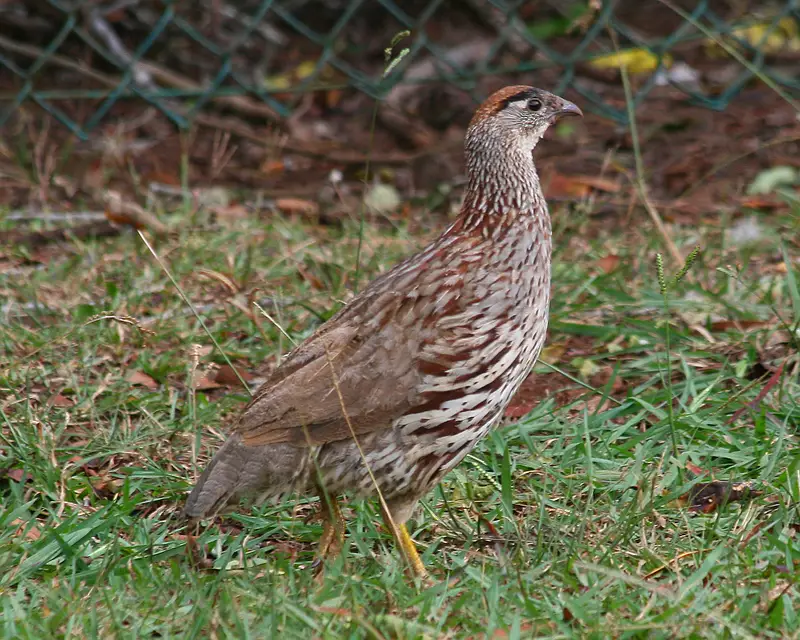
Erckel’s spurfowl is a species of game bird in the family Phasianidae. It was first described by German naturalist Eduard Rüppell, who named it after his assistant Theodor Erckel.
This beautiful bird has an array of colors – its plumage features shades of brown, white and black on its body with striking red wattles around their eyes and beak.
Their diet mostly consists of seeds, small insects like grasshoppers, beetles and termites as well as fruits found in forests or open areas near water bodies.
They are usually seen foraging alone or in pairs but can form large flocks during breeding season which takes place from February to June when males will perform courtship displays consisting of strutting along alternate routes while calling loudly to attract mates.
Erckel’s Spurfowl provides sport hunting opportunities throughout East Africa due to their abundance making them a popular quarry among hunters year-round.
Scientific classification:
| Kingdom | Animalia |
| Phylum | Chordata |
| Class | Aves |
| Order | Galliformes |
| Family | Phasianidae |
| Genus | Pternistis |
| Species | P. erckelii |
18. Hawaiian Coot
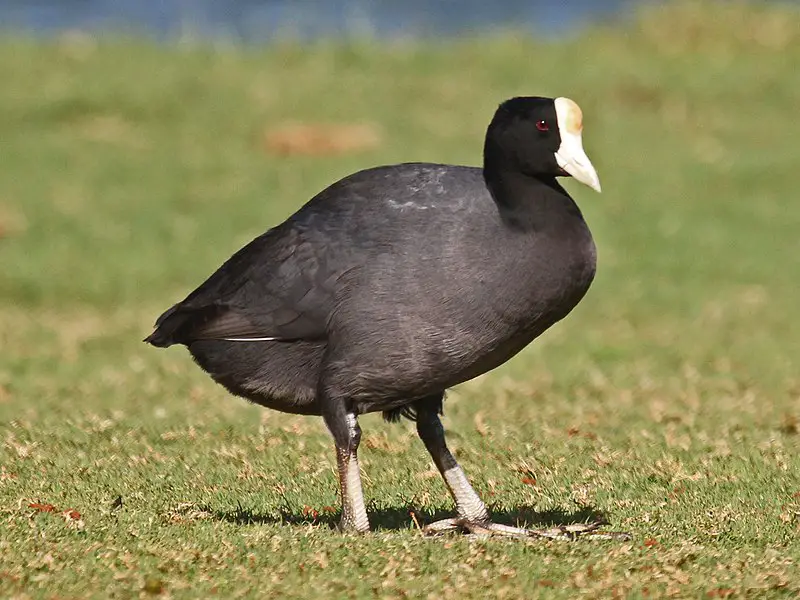
The Hawaiian Coot, also known as the ʻ’alae ke’oke’o in Hawaiian is a striking species of bird found only on the islands of Hawaii. It has an overall black plumage and a prominent white bill with a yellow spot at its base.
The coot measures 13-16 inches long and weighs about 1 pound 9 ounces when fully grown. They are quite similar to American Coots but have adapted well to their tropical home habitat over time.
Generally they can be seen foraging along lakes or wetlands where there is plenty of mud or shallow water available for them to feed from aquatic vegetation such as algae, grasses and insects that live beneath it’s waters surface .
These birds are highly social animals preferring company while swimming around together during mating season which occurs generally between spring and summer months each year in Hawaii.
Scientific classification:
| Kingdom | Animalia |
| Phylum | Chordata |
| Class | Aves |
| Order | Gruiformes |
| Family | Rallidae |
| Genus | Fulica |
| Species | F. alai |
19. Kauaʻi ʻōʻō
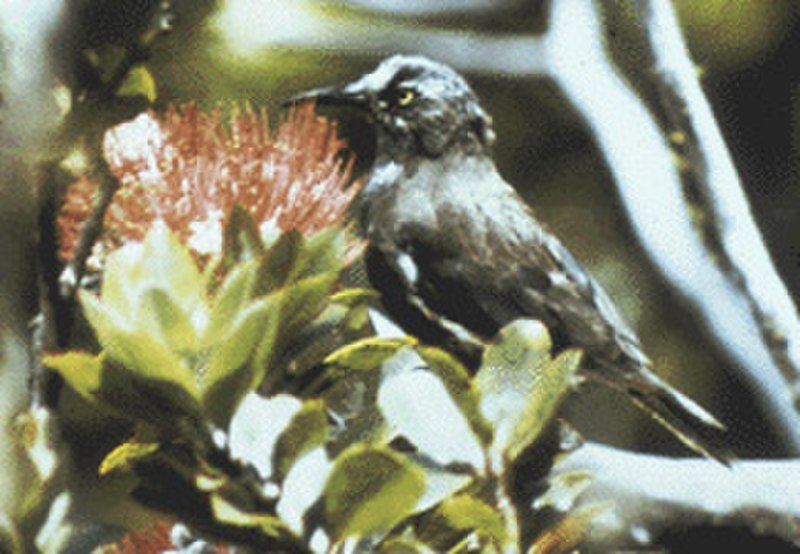
The Kauaʻi ʻōʻō was a medium-sized bird endemic to the Hawaiian island of Kauai. It belonged to the Mohoidae family and was part of the ʻōʻō genus until its extinction in 1987.
The bird had white feathers, with black wings and tail feather tips, as well as yellow feet and legs.
Its call sounded like “ooh-oo” or “ahh-ah”. The Kaua’i ‘O’O mainly fed on nectar from flowers but also ate insects such as beetles and ants.
This species lived primarily in subtropical forests, but due to habitat destruction it became increasingly rarer before finally becoming extinct in 1987 when the last known individual died out.
This is just one example of how human activity can lead to extinctions around us – it’s important that we help preserve what we have left.
Scientific classification:
| Kingdom | Animalia |
| Phylum | Chordata |
| Class | Aves |
| Order | Passeriformes |
| Family | †Mohoidae |
| Genus | †Moho |
| Species | †M. braccatus |
20. Moho
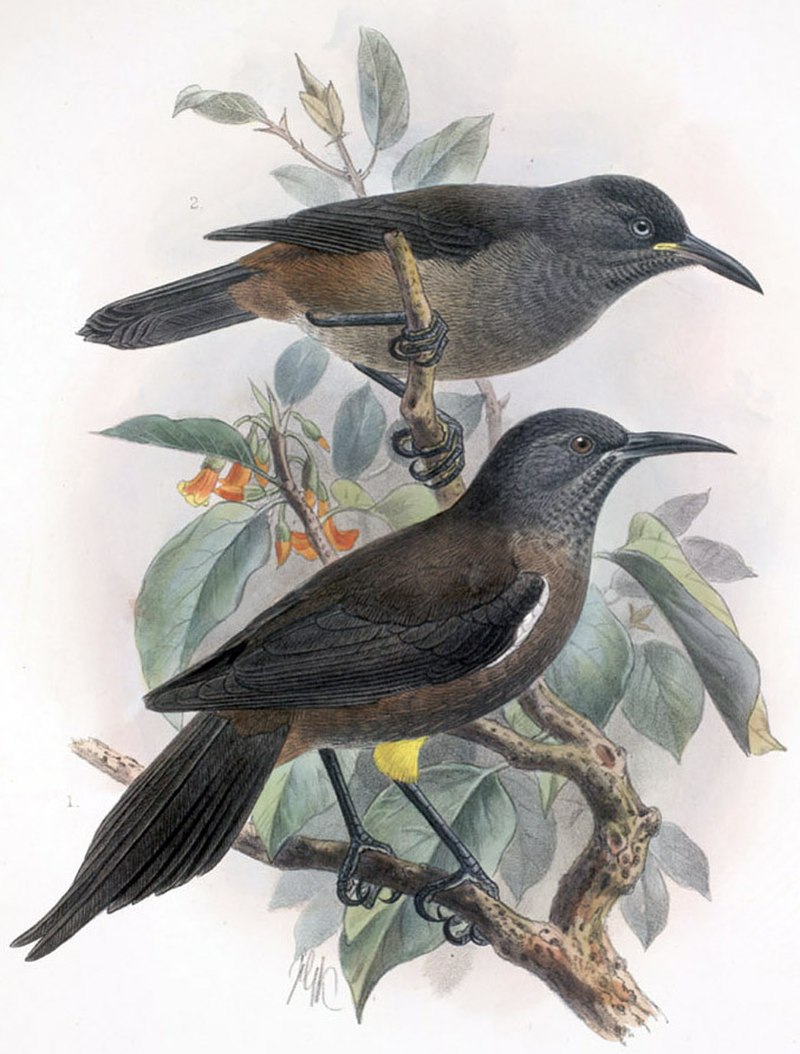
The Moho bird, known as ʻōʻō in Hawaiian, is an extinct genus endemic to the Hawaiian Islands. With striking glossy black plumage, some species had yellowish axillary tufts and black outer feathers.
Unfortunately, habitat loss and the introduction of mammalian predators led to the extinction of most of these species.
Despite their disappearance, the legacy of the Moho bird lives on in Hawaiian culture and serves as a reminder of the importance of conservation efforts to protect other endangered species around the world.
Scientific classification:
| Kingdom | Animalia |
| Phylum | Chordata |
| Class | Aves |
| Order | Passeriformes |
| Family | †Mohoidae |
| Genus | †Moho Lesson, 1830[1] |
21. Moorhen
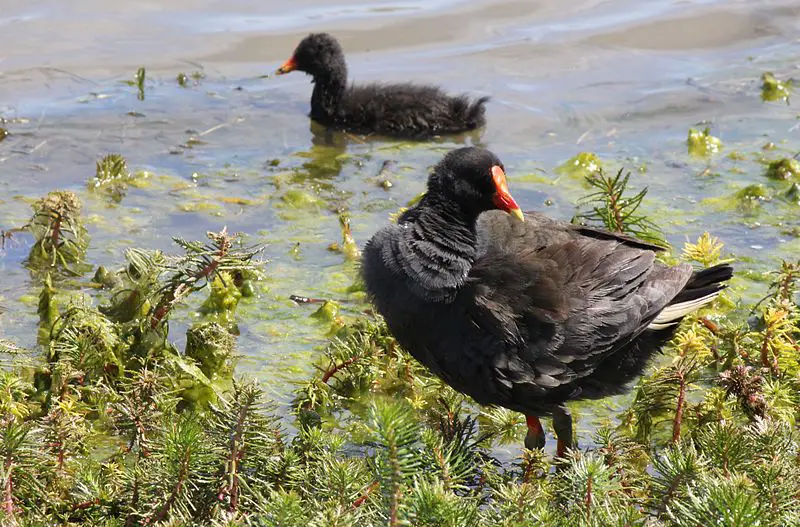
Moorhens are water birds that belong to the rail family. They are often called marsh hens and are medium-sized.
The Latin name for them is Gallinula, which means “little hen.” They are closely related to coots and are sometimes referred to as (black) gallinules.
One species of Gallinula was recently found to be different enough to form a new genus, called Paragallinula.
Moorhens are usually found near water sources such as lakes, ponds, and marshes. They have a black plumage and a red beak, and they are able to swim well.
They feed on aquatic plants, insects, and small fish. Moorhens are known for their territorial behavior and can be quite aggressive when defending their nests.
Scientific classification:
| Kingdom | Animalia |
| Phylum | Chordata |
| Class | Aves |
| Order | Gruiformes |
| Family | Rallidae |
| Genus | Gallinula Brisson, 1760 |
Also Featured In: Water Birds Live around Us, Wetlands Birds You Should Know
22. Common Moorhen
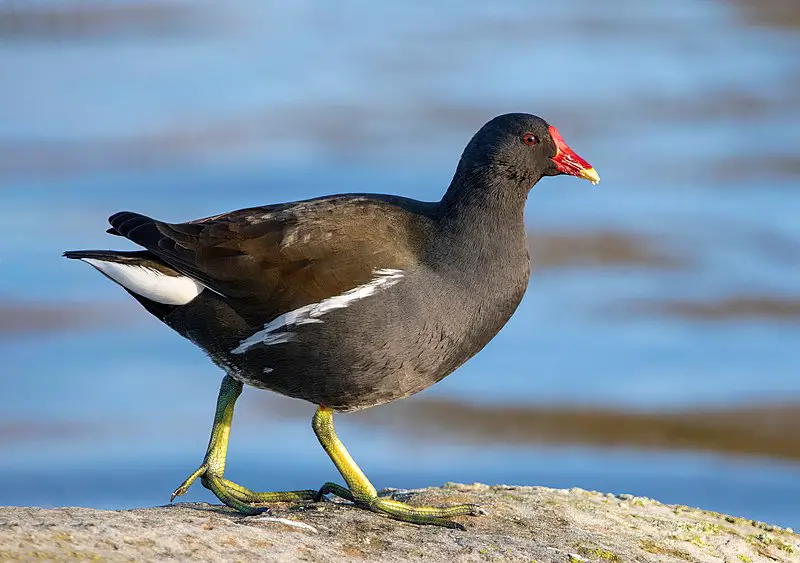
The common moorhen, also called waterhen or swamp chicken, belongs to the rail family and is widespread across various regions of the Old World.
These birds prefer to inhabit wetlands like canals, marshes, and ponds with rich vegetation. They are not found in polar regions or some tropical rainforests.
The species is known for its distinctive red forehead shield, which becomes more prominent during breeding season. Common moorhens usually feed on aquatic plants, small fishes, and invertebrates.
They are excellent swimmers and divers, but are also able to walk on floating vegetation. When threatened, they can flee by diving and swimming underwater.
Overall, common moorhens are fascinating birds that add to the diversity of wetland ecosystems.
Scientific classification:
| Kingdom | Animalia |
| Phylum | Chordata |
| Class | Aves |
| Order | Gruiformes |
| Family | Rallidae |
| Genus | Gallinula |
| Species | G. chloropus |
Also Featured In: Birds that Commonly Found in Pond , Amsterdam Birds You Should Know